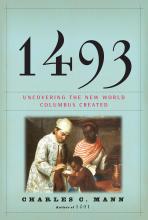1493 by Charles Mann '76

Two hundred million years ago, the world consisted of a single giant landmass. Geological forces broke it apart, creating the continents we know today. Separated by oceans, the eastern and western hemispheres had almost no communication for tens of millions of years. As a result, they developed entirely different suites of plants and animals. When Columbus came to the Caribbean, these separate biological world crashed together -- arguably the most important event in the history of life since the end of the dinosaurs, and definitely the beginning of globalization, and the hyper-connected world we live in today.
In the introduction, I tell readers that "1493" began in my garden, when I was ruminating about the fact that nothing I grew had originated within 2,000 miles of my home. But I could also say that the book began in Amherst College, when I took courses in history, ecology and anthropology that I now know were remarkably advanced for the time. When my Introduction to Historiography (History 12, if memory serves) course used computers to analyze census reports or asked us to correlate tree-ring data with famine records, it introduced me to some of the new ways of looking at history that I describe in the book. It's a pleasure to bring back a little of what I learned to Amherst Reads.